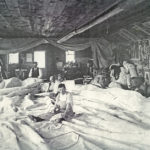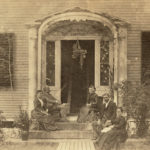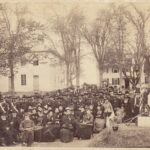The Nineteenth Century
 The years between the end of the War of 1812 and the outbreak of the Civil War in 1861 marked Castine’s years of greatest prosperity. Maine became a separate state in 1820, and Castine soon emerged as one of Maine’s leading commercial ports. Its wealth came mostly from the sea and the salt trade connected with it.
The years between the end of the War of 1812 and the outbreak of the Civil War in 1861 marked Castine’s years of greatest prosperity. Maine became a separate state in 1820, and Castine soon emerged as one of Maine’s leading commercial ports. Its wealth came mostly from the sea and the salt trade connected with it.
Every spring saw nearly five hundred fishermen awaiting salt to take to the fishing grounds. Over one hundred commercial sailing ships were built here. Rope walks, sail lofts, and ship chandleries, as well as skilled craftsmen such as pump and block makers, riggers, blacksmiths and tinsmiths, all met the needs of the maritime industry. According to one source, Castine in 1850 had the second-highest per capita wealth of any town or city in the United States.
The remains of the wharves and piers of that era may still be discerned by the careful observer. Street names like Perkins, Dresser and Dyer reminiscent of the merchant families of the pre-Civil War era. The town’s wealth is reflected today in the Federal and Greek Revival style homes on Main Street and Court Street.
By 1860 Castine’s population reached a nineteenth-century peak. It boasted three churches: the original Congregational (later Unitarian Universalist) meeting house on the Common, a Trinitarian Congregationalist church built in 1829, and a Methodist Church built in 1845. When the Civil War broke out in 1861, Castiners rallied to the Union, sending 157 men to serve in its armies. Rallies were held and women of the town raised funds for the cause. In 1887 a statue of a Union soldier was dedicated on the Common, honoring all who served.
Following the end of the war, Castine’s days as a commercial and fishing center were drawing to a close. Railroads and steamboats made it possible for goods and people to move faster than ever before. The fishing vessels that had once occupied the town’s wharves were replaced by steamboats carry tourists and summer residents – sometimes called “rusticators”. Hotels with exotic names like Shetola, Acadian, and Dome of the Rock were built to serve them.
The Eastern State Normal School opened its doors here in 1867, sending hundreds of teachers to Maine’s public schools. In 1897 an Episcopal chapel was built to accommodate many of the summer visitors, and later in 1921 a Roman Catholic chapel was consecrated, in part to serve the needs of the many servants brought by the summer residents.
Castine was enjoying a second era of prosperity. Near the end of the century, on July 9, 1896, the town celebrated the centennial of its charter. Citizens, sailors, and town dignitaries paraded down a handsomely decorated Main Street, after which an extensive program of prayers, songs, and rousing speeches took place at the Trinitarian church.
- Rope factory.
- Eastern State Normal School
- Sail Loft
- Upper Main Street
- Methodist Church
- Acadian Hotel
- Monument Dedication
- Lower Main Street










